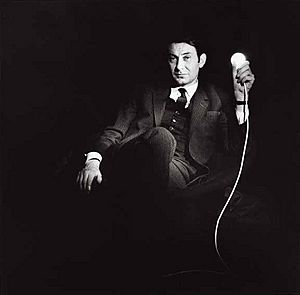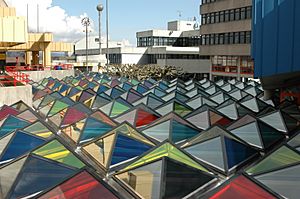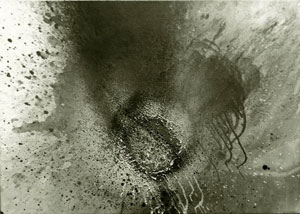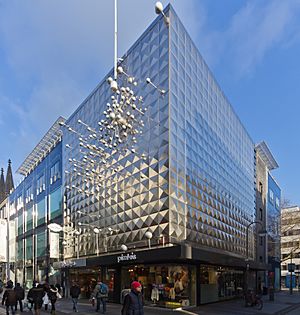Otto Piene facts for kids
Quick facts for kids
Otto Piene
|
|
|---|---|
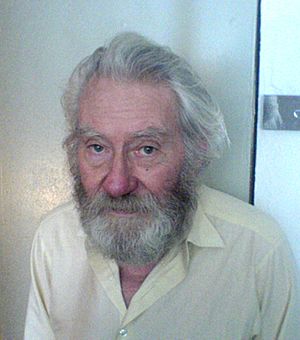
Otto Piene in 2007
|
|
| Born | 18 April 1928 Bad Laasphe, Province of Westphalia, Germany
|
| Died | 17 July 2014 (aged 86) |
| Nationality | German |
| Known for | Kinetic art, Performance art |
| Movement | Zero (art) |
| Awards | Leonardo da Vinci World Award of Arts (2003) |
Otto Piene (pronounced PEE-nah, 18 April 1928 – 17 July 2014) was a German-American artist. He was known for his art that used movement and technology, called kinetic art. He often worked with other artists and scientists. Piene lived and worked in Düsseldorf, Germany, and in Cambridge, Massachusetts and Groton, Massachusetts in the United States.
Contents
About Otto Piene
Otto Piene was born in 1928 in Bad Laasphe, Germany. He grew up in Lübbecke. When he was 16, he joined World War II as an anti-aircraft gunner. This meant he operated guns that shot at enemy planes. During the war, he was fascinated by the bright searchlights and artillery fire he saw at night. These glowing lines in the dark later inspired his art.
After the war, from 1949 to 1953, he studied painting and art education. He went to the Academy of Fine Arts, Munich and the Kunstakademie Düsseldorf. He also studied philosophy at the University of Cologne from 1952 to 1957.
Working in the United States
In 1964, Piene became a visiting professor at the University of Pennsylvania. From 1968 to 1971, he was the first artist to join the Center for Advanced Visual Studies (CAVS) at the Massachusetts Institute of Technology (MIT). CAVS was a special place where artists could work with advanced technology and scientists. It was a very collaborative environment, meaning artists worked together.
In 1972, Piene became a professor at MIT. He later became the director of CAVS in 1974. He held this important position until 1993. Piene stayed connected to CAVS and MIT for the rest of his life. He had homes in both Groton, Massachusetts and Düsseldorf, Germany.
Piene loved to work with others. He collaborated with many artists, scientists, and engineers. One famous person he worked with was Doc Edgerton, who was a pioneer in using fast flashes of light (stroboscopy). He also worked with astrophysicist Walter Lewin at MIT. Many of his large art projects needed many people to help. For example, his 1977 Centerbeam art project involved 22 artists and many scientists and engineers from different countries.
Otto Piene died on July 17, 2014, from a heart attack. He was on his way to an art event in Berlin, Germany. He was survived by his wife, Elizabeth Goldring, who was also an artist and poet. They often worked together. He also had four children, a stepdaughter, and five grandchildren.
Group Zero
In 1957, Otto Piene and Heinz Mack started an art group called ZERO. They wanted to create a new kind of art after World War II. In 1961, Günther Uecker joined them. By the 1960s, their group was known all over the world. Artists like Piero Manzoni, Yves Klein, Jean Tinguely, and Lucio Fontana were also part of the ZERO movement.
Piene and Mack also published ZERO Magazine from 1957 to 1967. In 2008, Piene, Mack, Uecker, and Mattijs Visser created the international ZERO foundation. This foundation keeps important records, photos, and documents about the ZERO artists and their work.
Artworks and Projects
In 1957, Piene created his Grid Picture series. These were paintings made by using stencils with small, regular dots. He used single colors like yellow, silver, white, or gold. An example is Pure Energy (1958).
Light and Smoke Art
Piene's art then grew into different forms. His Lichtballette ("light ballet", 1959) were an extension of his Grid Pictures. He used moving lamps to project light through grids. This made the viewer see space in new and exciting ways. This series was inspired by other artists' light-based works.
Also in 1959, Piene started combining his grids with fire sources like candles and gas burners. This created smoke traces and fire paintings. In these Rauchbilder ("smoke pictures"), he would lightly burn a layer of liquid on paper that had color. The soot left behind would form organic shapes. Piene saw fire and smoke as powerful natural energies. He continued to make "smoke pictures" throughout his career. Silver Fire (1973, Honolulu Museum of Art) is a well-known example.
Piene also experimented with combining different types of media. In 1963, he and other artists spoke about "the new idealism." He explored new ways to use television for art. In 1968, Piene and Aldo Tambellini created Black Gate Cologne. This was one of the first TV shows made by experimental visual artists.
Sky Art and Large Installations
In 1967, Piene started working on "Sky Art." He even came up with the term in 1969. This type of art used landscapes and cities as the main focus of his work. For the closing ceremony of the 1972 Summer Olympics in Munich, Piene created Olympic Rainbow. This artwork was made of five long, colorful tubes filled with helium gas. Each tube was about 600 meters (about 1,968 feet) long and floated in the sky. Between 1981 and 1986, Piene organized four Sky Art conferences in the US and Europe.
In the 1970s, he also designed some industrial products. He decorated a set of fancy tableware for a German porcelain company.
As the director of CAVS at MIT, Piene helped design a moving sculpture performance called Centerbeam. It was first shown in Kassel, Germany in 1977. Later, it was set up on the National Mall in Washington D.C. This huge artwork used laser-projected images on moving screens of steam. It also had 3-D holograms that tracked the sun, a 144-foot (about 44-meter) water prism, and sculptures that floated in the sky with helium.
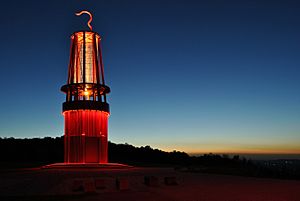
In 1999, Piene proposed a large statue called Das Geleucht (The Mining Lamp). This monument was shaped like a mining lamp and was built on a large pile of mining waste called Halde Rheinpreußen in Moers, Germany. It lights up every night. The monument is 30 meters (about 98 feet) high and was finished in 2007.
In 2011, Piene showed new public artworks as part of a festival celebrating MIT's 150th anniversary.
Exhibitions
Piene had his first solo art show in Düsseldorf in 1959. His Light Ballet debuted in New York in 1966. He represented Germany at the Venice Biennale in 1967 and 1971. He also showed his art at documenta in Kassel, Germany, in 1959, 1964, and 1977. In 1985, he exhibited at the São Paulo Art Biennial.
His solo exhibitions include large shows at the Kunstmuseum im Ehrenhof, Düsseldorf, in 1996, and at the Prague City Gallery in 2002.
More recently, his art has been shown at the MIT List Visual Arts Center (2011), the Museum Für Neue Kunst (2013), and the Neue Nationalgalerie in Berlin (2014). In 2014, the Solomon R. Guggenheim Museum in New York held a show about the Zero Group, which included many of Piene's works.
In 2019, the largest solo show of his work, Fire and Light: Otto Piene in Groton, 1983–2014, opened at the Fitchburg Art Museum. This museum is near his former home in Groton, Massachusetts.
Art Collections
Otto Piene's artworks are in over 200 museums and public collections around the world. Some of these include the Museum of Modern Art in New York, the Walker Art Center in Minneapolis, and the Centre Georges Pompidou in Paris. His art can also be found at the Harvard Art Museums and the List Visual Arts Center at MIT.
Awards and Recognition
In 1994, the University of Maryland, Baltimore County gave Piene an honorary Doctor of Fine Arts degree. In 1996, he received the Sculpture Prize from the American Academy of Arts and Letters in New York. In 2003, he won the Leonardo da Vinci World Award of Arts. This award recognized his amazing artistic and creative achievements.
After he passed away, Germany’s minister of culture, Monika Grütters, praised him. She said that his beautiful public artworks helped make cities more welcoming.
See also
 In Spanish: Otto Piene para niños
In Spanish: Otto Piene para niños
- Cai Guo-Qiang – A Chinese artist who also uses fireworks and burning gunpowder to create art.


